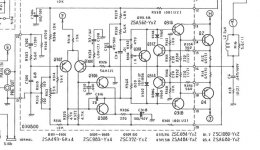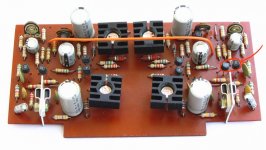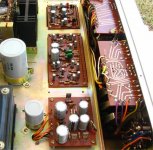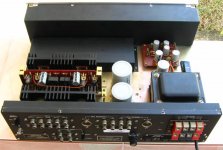Hi,
This is my first post to the forum. I've got a Monarch 8 Series 8000 amplifier. It's a circa 1976 model (I think) and it's recently developed a problem. After about 30 mins of use, a series of crackles come on in the left channel, some of them are loud and there is a kind of continuous low level noise (not really a hum, rather like white noise). It is not affected by the volume control. If the amp is turned off for a few hours and then turned on the "performance" repeats itself. But if the amp is turned on after a few minutes then the noise is immediately apparent.
I last had the amp serviced about 2 years ago in Australia, with complete PCB resoldering and general service. But I am now living in Thailand and good quality service for audio seems to be hard to come by here. So if I could find out what might be the problem, I would be happy to try a repair job myself. My skills here are limited to being able to solder plus some very basic knowledge of electronics.
I've attached the power amp part of the schematic. The main reason I would like to save this amp if possible is that it fits into my rather modest system of a Yamaha CD player, a Yamaha T-7 tuner and Yamaha NS 555 speakers very well. It's quite substantially built with shielding over the input circuitry and elsewhere.
I've had the covers off and cleaned the PCBs and checked for poor solder joints but couldn't see anything faulty. The amp does have what I think is a speaker protection device in each channel. This thing has two flat strips of metal with what look like contacts enclosed in a small glass envelope. Maybe some kind of bimetal switch which heats up and opens (hopefully) when any DC is present. I did think that this might be the cause of the noise. But I haven't done a channel swap to check that yet.
I would be grateful for any help that forum members might be able to offer.
regards
Roy
This is my first post to the forum. I've got a Monarch 8 Series 8000 amplifier. It's a circa 1976 model (I think) and it's recently developed a problem. After about 30 mins of use, a series of crackles come on in the left channel, some of them are loud and there is a kind of continuous low level noise (not really a hum, rather like white noise). It is not affected by the volume control. If the amp is turned off for a few hours and then turned on the "performance" repeats itself. But if the amp is turned on after a few minutes then the noise is immediately apparent.
I last had the amp serviced about 2 years ago in Australia, with complete PCB resoldering and general service. But I am now living in Thailand and good quality service for audio seems to be hard to come by here. So if I could find out what might be the problem, I would be happy to try a repair job myself. My skills here are limited to being able to solder plus some very basic knowledge of electronics.
I've attached the power amp part of the schematic. The main reason I would like to save this amp if possible is that it fits into my rather modest system of a Yamaha CD player, a Yamaha T-7 tuner and Yamaha NS 555 speakers very well. It's quite substantially built with shielding over the input circuitry and elsewhere.
I've had the covers off and cleaned the PCBs and checked for poor solder joints but couldn't see anything faulty. The amp does have what I think is a speaker protection device in each channel. This thing has two flat strips of metal with what look like contacts enclosed in a small glass envelope. Maybe some kind of bimetal switch which heats up and opens (hopefully) when any DC is present. I did think that this might be the cause of the noise. But I haven't done a channel swap to check that yet.
I would be grateful for any help that forum members might be able to offer.
regards
Roy
Attachments
Thanks for the suggestions. I'll try voltage measurement first as it is the easiest to do. I know that channel comparison is the way to go to isolate the fault but I really could do with some advice on where to start first. I'm familiar with the physical layout of the amp but not the details of voltages etc. Any general suggestions on how to go would be very welcome.
Hi Roy,
That doesn't look like it's too bad a little amp. Absolutely, fix it.
That "white noise" sounds like a transistor breaking down. Old carbon composition resistors could make this sound also.
So, I'd replace all the electrolytic caps if I were you. Take a picture or four before you start in case a component spins in your fingers. Most these caps have a polarity.
After this, allow the amp to begin making the noise. With a can of freeze spray, cool one transistor at a time. Wait at least 10 sec between each attempt to give the spray time to work. A little frost is enough, and that takes a second to appear after you stop spraying. Start with the small transistors first (Q302,304,306,308). Then move on to Q316,318 2 and 4. If you suspect a transistor, test it by warming it up (noise starts) and cooling it down (noise stops).
If you feel the breaker is causing the noise, play low level music, a tone is better. Tap the device to see if the sound cuts out.
-Chris
That doesn't look like it's too bad a little amp. Absolutely, fix it.
That "white noise" sounds like a transistor breaking down. Old carbon composition resistors could make this sound also.
So, I'd replace all the electrolytic caps if I were you. Take a picture or four before you start in case a component spins in your fingers. Most these caps have a polarity.
After this, allow the amp to begin making the noise. With a can of freeze spray, cool one transistor at a time. Wait at least 10 sec between each attempt to give the spray time to work. A little frost is enough, and that takes a second to appear after you stop spraying. Start with the small transistors first (Q302,304,306,308). Then move on to Q316,318 2 and 4. If you suspect a transistor, test it by warming it up (noise starts) and cooling it down (noise stops).
If you feel the breaker is causing the noise, play low level music, a tone is better. Tap the device to see if the sound cuts out.
-Chris
Touch with a soldering iron the components leads
This way you may find the defective component.
Do it with the amplifier switched on...no signal in the input..and listen to detect the noise..... wait component to absorb the heat from the soldering iron...listen at the speakers searching for the damaged part.
Of course sensitive stages will amplify the AC noise captured by your soldering iron metal chassis....when testing those stages reduce the volume for some seconds...remove the soldering iron and turn the volume up again.
regards,
Carlos
This way you may find the defective component.
Do it with the amplifier switched on...no signal in the input..and listen to detect the noise..... wait component to absorb the heat from the soldering iron...listen at the speakers searching for the damaged part.
Of course sensitive stages will amplify the AC noise captured by your soldering iron metal chassis....when testing those stages reduce the volume for some seconds...remove the soldering iron and turn the volume up again.
regards,
Carlos
Hi Carlos,
I do this as well, but you must be very careful not to overheat the part.
-Chris
I do this as well, but you must be very careful not to overheat the part.
No! You must hold near a non-conductive part of the casing. Touching the lead may (probably) upset normal circuit operation. Many irons also have ground referenced tips these days.Touch with a soldering iron the components leads
-Chris
Hi,
It's been a fair while since my last post (work etc intervening) but I do have some progress to report.
I used the freeze spray, as suggested, and when I sprayed two transistors (Q302 and Q304 in the schematic and red outlined in the pic) on the power board, making sure they had frost on them, the crackling noise stopped instantly.
And interestingly, the noise has not returned even after about 24 hours of continuous use or being left on. I used the amp both with the cover on and off - no noise either way. I ran the amp biwired to the speakers at around 11 o/c volume, the heatsinks got quite warm but no noise reappeared. I thought that the freeze spray might have affected a dry solder joint, but I couldn't see any sign of that. And, in any case, when the amp was checked out a couple of years ago, the tech resoldered all the joints.
So I'm wondering what might be the next step. Should I replace the 2 transistors on each side. If so, are these transistors sitll available (or could somebody please give their equivalents).
From my very limited understanding of amps, if the transistors were replaced it would be necessary to adjust the DC offsets and quiescent currents. Would it be necessary to replace the trimpots with sealed ones, for example, following the recommedations here http://www.tnt-audio.com/clinica/bias_e.html
Any comments on all this would be welcome.
It's been a fair while since my last post (work etc intervening) but I do have some progress to report.
I used the freeze spray, as suggested, and when I sprayed two transistors (Q302 and Q304 in the schematic and red outlined in the pic) on the power board, making sure they had frost on them, the crackling noise stopped instantly.
And interestingly, the noise has not returned even after about 24 hours of continuous use or being left on. I used the amp both with the cover on and off - no noise either way. I ran the amp biwired to the speakers at around 11 o/c volume, the heatsinks got quite warm but no noise reappeared. I thought that the freeze spray might have affected a dry solder joint, but I couldn't see any sign of that. And, in any case, when the amp was checked out a couple of years ago, the tech resoldered all the joints.
So I'm wondering what might be the next step. Should I replace the 2 transistors on each side. If so, are these transistors sitll available (or could somebody please give their equivalents).
From my very limited understanding of amps, if the transistors were replaced it would be necessary to adjust the DC offsets and quiescent currents. Would it be necessary to replace the trimpots with sealed ones, for example, following the recommedations here http://www.tnt-audio.com/clinica/bias_e.html
Any comments on all this would be welcome.
Attachments
Hi Roy,
Bingo!
Don't worry, the noise will come back. Replace those with 2SA970 (match the gains). Touch the cases together with a touch of heatsink grease between them.
Your 2SA493 are rated at 50V, 150mA, 400mW and a beta of 120 ~ 400 against the 2SA970 which is 120V, 100mA, 300mW and a beta of 200 ~ 700. I don't think that circuit comes close to exceeding the 2SA970's ratings. Buy a bunch so you can match them in pairs. You can use others but the 2SA970 is a very linear transistor, good for diff pairs. They should be available. Don't bother with replacement brands at all.
Your trim pots are fine. Use some contact cleaner on the center metal part and work the control a few times. Reset it to the dent, you can feel it lightly while rotating the control. Sealed pots can get noisy just as fast and multiturn controls will not help you. I would worry about those more than the originals.
-Chris
Bingo!
Don't worry, the noise will come back. Replace those with 2SA970 (match the gains). Touch the cases together with a touch of heatsink grease between them.
Your 2SA493 are rated at 50V, 150mA, 400mW and a beta of 120 ~ 400 against the 2SA970 which is 120V, 100mA, 300mW and a beta of 200 ~ 700. I don't think that circuit comes close to exceeding the 2SA970's ratings. Buy a bunch so you can match them in pairs. You can use others but the 2SA970 is a very linear transistor, good for diff pairs. They should be available. Don't bother with replacement brands at all.
Your trim pots are fine. Use some contact cleaner on the center metal part and work the control a few times. Reset it to the dent, you can feel it lightly while rotating the control. Sealed pots can get noisy just as fast and multiturn controls will not help you. I would worry about those more than the originals.
-Chris
Hi Chris,
Thanks for the help. I'll be looking around locally for the 2SA970 transistors but I think I'll have to go to an overseas supplier.
Electronix Online http://www.electronix.com/ have them in stock so I may go there but I'll look around further on the net.
As for getting matching pairs, could you give me some pointers on that.
Like what value needs to be matched and the tolerance required. I have a digital m/meter, is any other instrumentation needed?
As you can see I'm learning as I go here, but no problem there.
I'll post some more pics of the amp when I get home tonight.
Roy
Thanks for the help. I'll be looking around locally for the 2SA970 transistors but I think I'll have to go to an overseas supplier.
Electronix Online http://www.electronix.com/ have them in stock so I may go there but I'll look around further on the net.
As for getting matching pairs, could you give me some pointers on that.
Like what value needs to be matched and the tolerance required. I have a digital m/meter, is any other instrumentation needed?
As you can see I'm learning as I go here, but no problem there.
I'll post some more pics of the amp when I get home tonight.
Roy
I've turned up this article on the ESP site
http://sound.westhost.com/transistor-matching.htm
giving what seems to be a pretty good overview of what's involved in transistor matching. I was wondiering tho' if the matching procedure could be simplified just check out the parameters for the smaller transistors like the ones I need.
I've been unable to locate any 2SA970s locally so I will need to get them from overseas. Are there any counterfeiting or faking issues with the smaller transistors?
I've attached a pic of the amp with the covers off.
Roy
http://sound.westhost.com/transistor-matching.htm
giving what seems to be a pretty good overview of what's involved in transistor matching. I was wondiering tho' if the matching procedure could be simplified just check out the parameters for the smaller transistors like the ones I need.
I've been unable to locate any 2SA970s locally so I will need to get them from overseas. Are there any counterfeiting or faking issues with the smaller transistors?
I've attached a pic of the amp with the covers off.
Roy
Attachments
Hi Roy,
Buy 10 or 20 transistors (they should not be expensive) and you can get some excellent matches. You want to match the beta. You can use the hFE function in your DVM, but my Heathkit IT-18 gives much better results. You don't care what the actual value is as much as how close they are. Pick the highest gain devices that are matched.
Basically, inject a base current and measure the collector current. You can try to measure the base current, then the collector current (difficult since the base current will be uA). The base current will be your target collector current divided by the beta (approximately). So if you want 1 mA collector current (good test value as that's where the transistor normally operates), the base current may be 0.0025mA assuming a gain of 400. That's a small current. Your meter may upset that reading.
It may be better to supply the base through a variable supply and some resistance that gets you in the range and note the voltages to give 1 mA collector current. Match them on that basis. Use 5 to 10 volts for your collector supply and a 1K resistor to measure across.
-Chris
Buy 10 or 20 transistors (they should not be expensive) and you can get some excellent matches. You want to match the beta. You can use the hFE function in your DVM, but my Heathkit IT-18 gives much better results. You don't care what the actual value is as much as how close they are. Pick the highest gain devices that are matched.
Basically, inject a base current and measure the collector current. You can try to measure the base current, then the collector current (difficult since the base current will be uA). The base current will be your target collector current divided by the beta (approximately). So if you want 1 mA collector current (good test value as that's where the transistor normally operates), the base current may be 0.0025mA assuming a gain of 400. That's a small current. Your meter may upset that reading.
It may be better to supply the base through a variable supply and some resistance that gets you in the range and note the voltages to give 1 mA collector current. Match them on that basis. Use 5 to 10 volts for your collector supply and a 1K resistor to measure across.
-Chris
Just a brief update - I've ordered 20 2SA970 transistors from Electronix , should have them within a week. As suggested, the next step will be to check out the individual gains. I'll post the results as soon as I have them. After that I'll look at the caps.
Thanks for the help Chris.
Thanks for the help Chris.
I now have 20 2AS970s and testing their hFEs on my DMM gave the following results
1x252, 1x253, 1x255, 3x262, 1x275, 1x281, 1x283, 2x285, 1x291, 1x300, 1x302, 1x304, 1x305, 2x313, 1x323, 1x325.
I will have to replace two pairs of transistors on the power board (as I understand it). How critical is matching the pairs and what would be the best way to go? For example, would it be OK to use the 2x313 pair on one channel and the 323 and 325 on the other? Or would another arrangement like the 300, 302 and the 304 and 305 be better?
thanks for all the help given to this electronics newbie and the season's greetings to all
Roy
1x252, 1x253, 1x255, 3x262, 1x275, 1x281, 1x283, 2x285, 1x291, 1x300, 1x302, 1x304, 1x305, 2x313, 1x323, 1x325.
I will have to replace two pairs of transistors on the power board (as I understand it). How critical is matching the pairs and what would be the best way to go? For example, would it be OK to use the 2x313 pair on one channel and the 323 and 325 on the other? Or would another arrangement like the 300, 302 and the 304 and 305 be better?
thanks for all the help given to this electronics newbie and the season's greetings to all
Roy
Hi Chris,
I've just received another 20 2SA970s from Electronix, the others I posted about before, I bought in Bangkok (very cheap, around 9c each). The hFEs of this new lot are higher than the first ones:
390, 392, 393, 398, 399, 400, 404, 407, 410, 410, 420, 422, 427, 430, 432, 449, 455, 471, 500, 501. The markings are different too.
The first group were marked:
A970
GR 2H
the second:
A970
BL 8B
Two questions, what do these different marks indicate (if anything) and are the higher hFEs to be preferred?
Also, I managed to score another Monarch amp, same model and while not as good cosmetically as the first one, it sounds pretty good. So my plan now is to repair and do a mild upgrade on the noisy one while using the other.
Roy
I've just received another 20 2SA970s from Electronix, the others I posted about before, I bought in Bangkok (very cheap, around 9c each). The hFEs of this new lot are higher than the first ones:
390, 392, 393, 398, 399, 400, 404, 407, 410, 410, 420, 422, 427, 430, 432, 449, 455, 471, 500, 501. The markings are different too.
The first group were marked:
A970
GR 2H
the second:
A970
BL 8B
Two questions, what do these different marks indicate (if anything) and are the higher hFEs to be preferred?
Also, I managed to score another Monarch amp, same model and while not as good cosmetically as the first one, it sounds pretty good. So my plan now is to repair and do a mild upgrade on the noisy one while using the other.
Roy
Hi Roy,
The BL and GR are gain ranges, or groupings. That is why you see markedly different trends in gain measurements.
The higher hFE numbers are what we would historically use in diff. pairs, so your 500, 501 and 430, 432 pairs are what I'd use. Keep the other matches together for the other one. You can bounce back and forth to assess whether changes are beneficial or not. Look at things like DC offset and bias current stability as the unit warms up as well.
-Chris
The BL and GR are gain ranges, or groupings. That is why you see markedly different trends in gain measurements.
The higher hFE numbers are what we would historically use in diff. pairs, so your 500, 501 and 430, 432 pairs are what I'd use. Keep the other matches together for the other one. You can bounce back and forth to assess whether changes are beneficial or not. Look at things like DC offset and bias current stability as the unit warms up as well.
-Chris
- Status
- This old topic is closed. If you want to reopen this topic, contact a moderator using the "Report Post" button.
- Home
- Amplifiers
- Solid State
- Problem with Monarch 8 Series 8000 amp




